by Briscoe White | Feb 10, 2012 | Life on the Farm, Miscellaneous, Seeds, Wildlife |
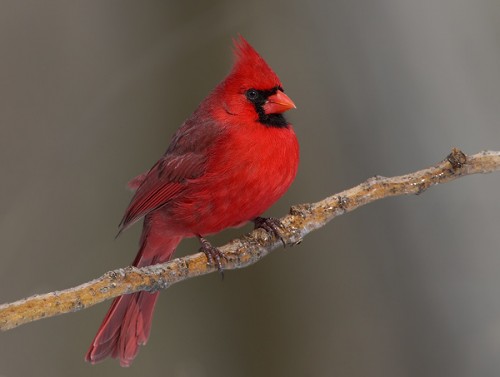
February is National Bird Feeding Month, and though we’ve had a fairly mild winter, here in zone 7, our feathered friends still need your attention. No matter where you reside, the birds in your area could use a helping hand during these cold, dreary months where weather may be harsh or unpredictable and food can be scarce. Here are a few tips to ensure that your bird buddies are well fed and warm until springtime arrives:
Water Through The Winter. Birds need a fresh source of water, so make sure to break and remove any ice that may accumulate in your bird baths, and replenish the water regularly. Our Bamboo themed Mini Oriental Bird Bath makes the perfect compact addition to your garden and gives birds plenty of fresh water to drink and play!
Cleaning is Key. Routinely clean debris from bird baths and old seed from bird feeders to prevent fungus and disease from developing and making the birds sick.
Home Tweet Home. Give your birds plenty of dry, protected places to nest for the winter. Hang birdhouses in areas that are out of the wind and weather to provide a great winter home for birds that don’t migrate. Looking for a cozy country-inspired home for your birds? Our Red Wooden Birdhouse compliments your country garden with a rustic look to give your birds the best place to nest year round!
Treats For Tweets. I have vivid memories of my mother placing halves of too-far gone oranges, apples and pears; mushy bananas, dried nuts and other edible compost out along the snow covered railings of our porch, for the mockingbirds. Songbirds LOVE fruit! Giving your birds additional nutrition keeps their diet balanced while giving them something new to instigate, while giving you a great natural show to watch from indoors.
Feed the Flock. Don’t forget to regularly refill your bird feeders and inspect them for winter damage. Replace cracked or broken feeders as needed with new ones.Our Glass Bamboo Feeder is made of thick, hand-blown glass and brass so it’s sturdy enough to withstand winter’s worst!
Out Smart the Squirrels. Other critters may be competing for food sources during this time of the year. Try to hang your feeders in areas that squirrels can’t get to, or attach guards or cages to keep them from stealing all of your birdseed. Alternatively, you can find the best squirrel proof bird feeder at the Ballachy website to prevent these pesky animals from getting to the bird food.
Select The Right Seed. Suet cakes are a great “hodge podge” of high calorie seeds that come in different varieties to attract specific types of winter birds. Peanuts and Nyger seeds are other high calorie nuts and seeds that will ensure your birds stay plump and warm this winter.
by Briscoe White | Jan 13, 2012 | Life on the Farm, Miscellaneous, Wildlife |
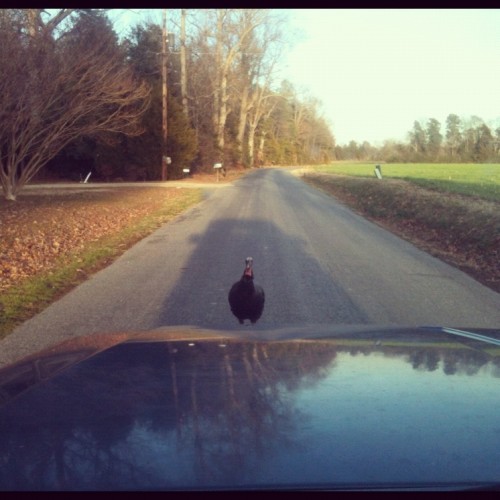
On her way home, our Marketing Director, Caroline, encountered a pretty tough bird. It’s a good thing it didn’t have a flock, or this might have gotten ugly…
There’s one house on the way to the farm, that I always slow to a crawl when I past. The Raniers. In the mornings, their motley crew of dogs, comprised of two labs, one black and one yellow; a stout little beagle, and a bug eyed chihuahua bask in the warm sun in the middle of the one lane country road, or explore the ditches and field adjoining the road’s worn pavement. They’ve become kind of like friends, as I pass them each morning and think “good dogs” to myself and while struggling to get that last drop of coffee out of my travel mug.
The afternoons are a bit of a different story. Replacing my familiar furry friends is a flock of nervous barnyard fowl, ranging from roosters to chickens in various and sundry breeds, and a wild turkey. Yes, I said wild. Apparently, Jamie and Lori, the owners of this tiny ranch, raised this turkey from an egg their son Hunter found. The turkey has grown to assimilate to its much smaller family of chickens without even noticing that its giant stature makes it so different. Now, while I wish no ill will on Hunter’s hand-reared turkey, I do have a particular penchant for dining on wildfowl, especially in the fall – as we all do. I have friends who have invested in a game cam which they have been using to locate and pick out turkeys roaming in the wilderness. Maybe they will let me join them someday; I find that sort of technology interesting and I’d like to see it in use.
On my way home, like any other day, I slowed as I approached the birds while they meandered across the road, scratching and pecking in the dirt that surrounds the blacktop. The only thing different about this encounter was that the turkey stood firmly in the middle of the road, refusing to budge. As I nudged my car closer, it began walking toward me, never breaking its defiant gaze. I finally put the car in park when I realized that I wasn’t going to win this game of “chicken” (pun intended), and stared back. It looked at me as if to say “this is my turf” without caring in the least that I was in a Jeep, and that it was outweighed and out horse powered. I jumped out and shooed it out of the road, and to my surprise as it slightly side stepped my path, it pecked at me! I jumped into my car and looked in the rear view as I began to pull away: the turkey was there. As if from some nightmarish Hitchcock movie, I was now being stalked mercilessly…by an evil turkey. I sped up, and he sped up. It wasn’t until I’d hit almost 25 MPH that he gave up his chase for an easier pursuit.
I got a good laugh from my friends when I told them about my day and my face off with the ornery bird, and still cautiously drive past the Ranier’s in the afternoon, always looking back for fear of that crazy turkey!
by Briscoe White | Aug 12, 2011 | Miscellaneous |
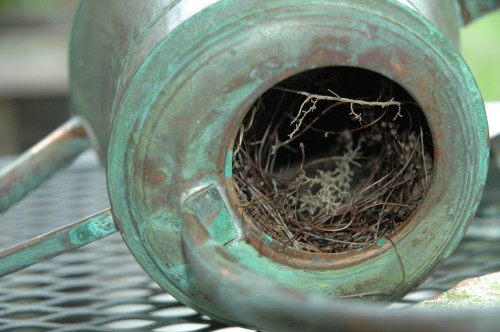
Carolina Wrens will nest just about anywhere...even in our empty watering can!
Carolina Wrens, though territorial about their range, are not picky about where they nest. Old boots, propane tanks, watering cans, mailboxes and pots…these are just some of the man made abodes that wrens have claimed as their “home sweet home”. Using everything from small sticks, moss and roots, to snakeskin, plastic bags, hair and paper, Wrens are resourceful home builders!
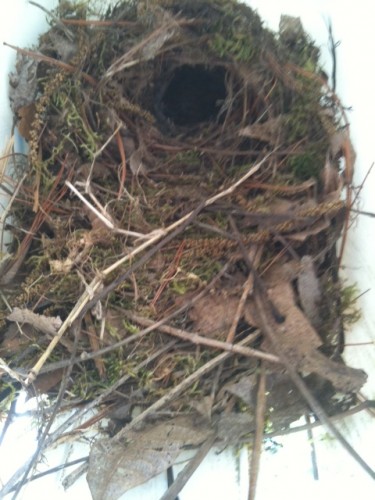
Wrens built this cozy nest in our marketing director, Caroline's, grandma's newspaper box!
The mating pair, which stays together for life, spend their time foraging for sturdy materials for the curved outer walls, and finish the inside up with softer nesting materials. Wrens may also build many mock nests throughout their territory, which are commonly called “cock’s nests”, choosing their favorite home for the nesting season once they are actually ready to mate. These domed nests are never used more than once and usually take about three days to construct. Once finished, the pair mate and the female lays a clutch of between three and seven small eggs that are cream colored with small brown speckles. To watch them in action, check out this great YouTube video of a pair of Carolina Wrens adding to their nest! Building a Carolina Wren Nest.
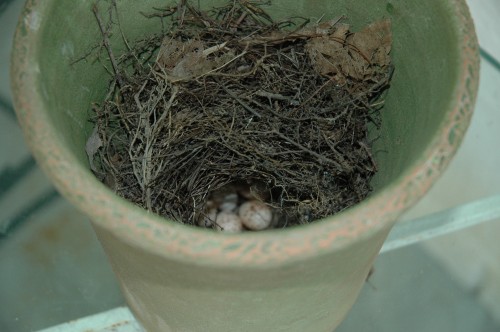
Our wrens chose the stylish pot on our office's front porch to nest in. They must not be bothered by the constant activity here since they've already laid eggs!
For a hilarious and heartwarming story with great pictures documenting the baby wrens, check out this website on the wren’s unusual nesting locations, and read about Karen Ouimet’s indoor wren experience!
by Briscoe White | Jul 21, 2011 | Miscellaneous |
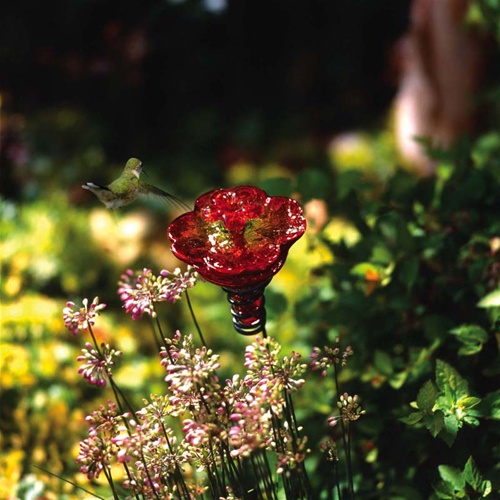
There are three varieties of Hummingbirds that frequent our area in Virginia, the Rufous, Allen’s and the Ruby Throated hummingbird. Our favorite is the last but not least in that list, for its brilliant hues and and signature ruby-red colored throat.
Highly curious and very attracted to feeders, the Ruby Throat is one of the most common and recognizable hummingbirds in the eastern half of North America. Living up to their name, males have vibrant green feathers, white stomachs and a red “ruby” throat, while females are larger and resemble males in coloring, but lack that namesake red throat. Hummingbirds often become so adapted to people that they may even dive closer to explore your red wardrobe, and seem indifferent to being watched closely while feeding near windows or patios. Hanging a hummingbird feeder near a large window is one of the most relaxing ways to pass time, as many males become territorial over their feeder and spend a lot of time chasing others away. (If hanging a feeder is difficult, we also have a great Staked Hummingbird Feeder that includes a stake for easy placement.) These fast, feathered air battles are more dramatic than your favorite soap opera and more entertaining than most sporting events! It’s best to place multiple hummingbird feeders throughout your yard, out of sight of each other, so that territorial lines aren’t crossed as often and everyone gets a chance to feed. Placing your feeders in the shade will also help give these hardworking hummers a respite from the hot summer sun!
Most of these hummers migrate to the deep south and Caribbean to wait out the cold winters, but tend to show back up with the blooming of spring flowers in late April and early June, here on the east coast. Beautiful and entertaining, these quick, little birds are terrific pollinators in your garden and drink half to eight times their body weight in nectar, and frequently dine on small, soft insects. During the sweltering summer months, make sure to change the sugary “nectar” in each of your feeders once a week, regardless of whether the birds have been feeding or not. This keeps the sugar-water fresh, as it will actually spoil in the summer heat. Though they love red, tubular shaped flowers, they will visit other sweetly-scented blossoms and blooming aromatic herbs as well. Try planting Asclepias ‘Tuberosa’, Bergamot and Lobelia to create a hummingbird habitat in your garden. Doing so will increase the health of your garden and give you a great, natural hive of activity to study!
by Briscoe White | Feb 17, 2011 | Herbs, Life on the Farm, Miscellaneous, Wildlife |
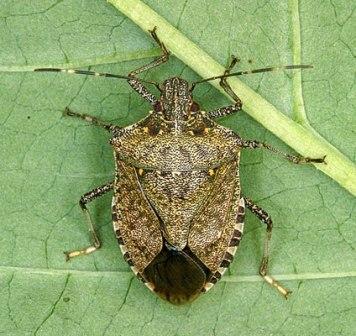
For many of us on the East Coast (particularly MD, DC and VA), this time of year not only marks the first warm weeks which hint of the coming spring season; it means to prepare for the invasion. It’s not a terrorist or nuclear threat we’re talking about…it’s something far smellier: stinkbugs. In 2010 our region suffered a swarm of these foul little pests and as we begin seeing warmer weather in this (hopefully) early spring, they are beginning to settle in like unwanted house guests.
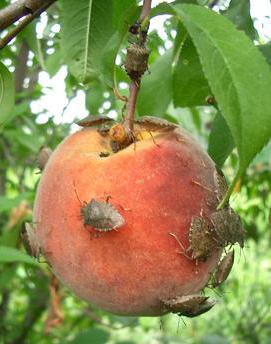
Though they don’t bite or sting, they do emit a pretty putrid odor when crushed, smooshed, vacuumed up, or squished, and though they are more of an annoyance for homeowners, local farmers are beginning to fret. Stinkbugs prey on crops like raspberries, tomatoes, peaches and other fruits, sucking the juices out of them and leaving them undesirable. Especially in the organic farming community, who strive not to use harmful pesticides, concern is on the rise. So, what is your best line of garden defense against these pungent perpetrators? The all natural answer is herbs!
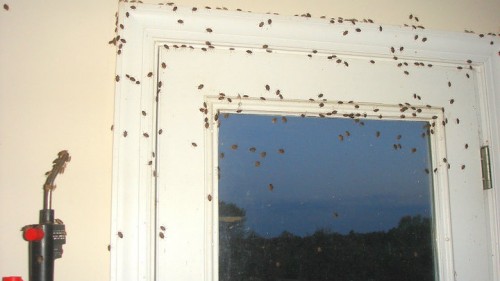
Don't let this happen to your home!
Strongly scented herbs such as Mint, Lavender, Catnip, and Patchouli have been proven to thwart the little stinkers from overwhelming you favorite fruits and veggies. (It’s hard to believe that they are picky about smells…I guess everyone likes their own brand!) You can also try planting other natural insect deterrents around your home or garden like Tansy, ‘Citronella’ Scented Geraniums, Pyrethrums and Rue to keep the bugs at bay. For the insidious insects that have already made it indoors, try making sachets with some of these herbs or use their essential oils to coat your window sills and thresholds. This will hopefully keep the rest of the stinkbugs from sneaking in and joining their friends inside your nice warm home. You can also fill jars with soapy water to catch the critters that have already begun to show up indoors, as the soap will dissolve their exoskeleton, killing them in a non-toxic way.
In conjunction with February being National Bird Feeding Month, try attracting birds to your garden with feeders, houses and baths, to keep your bug problem to a minimum. We’ve heard that blue jays are fond of these stinky little snacks, so encourage them and other seed-eating friends to nest around your yard to prevent the problem from getting out of hand. Bats also find stink bugs to be a delicacy, so place bat boxes throughout your yard and near the garden to help battle the bugs.









